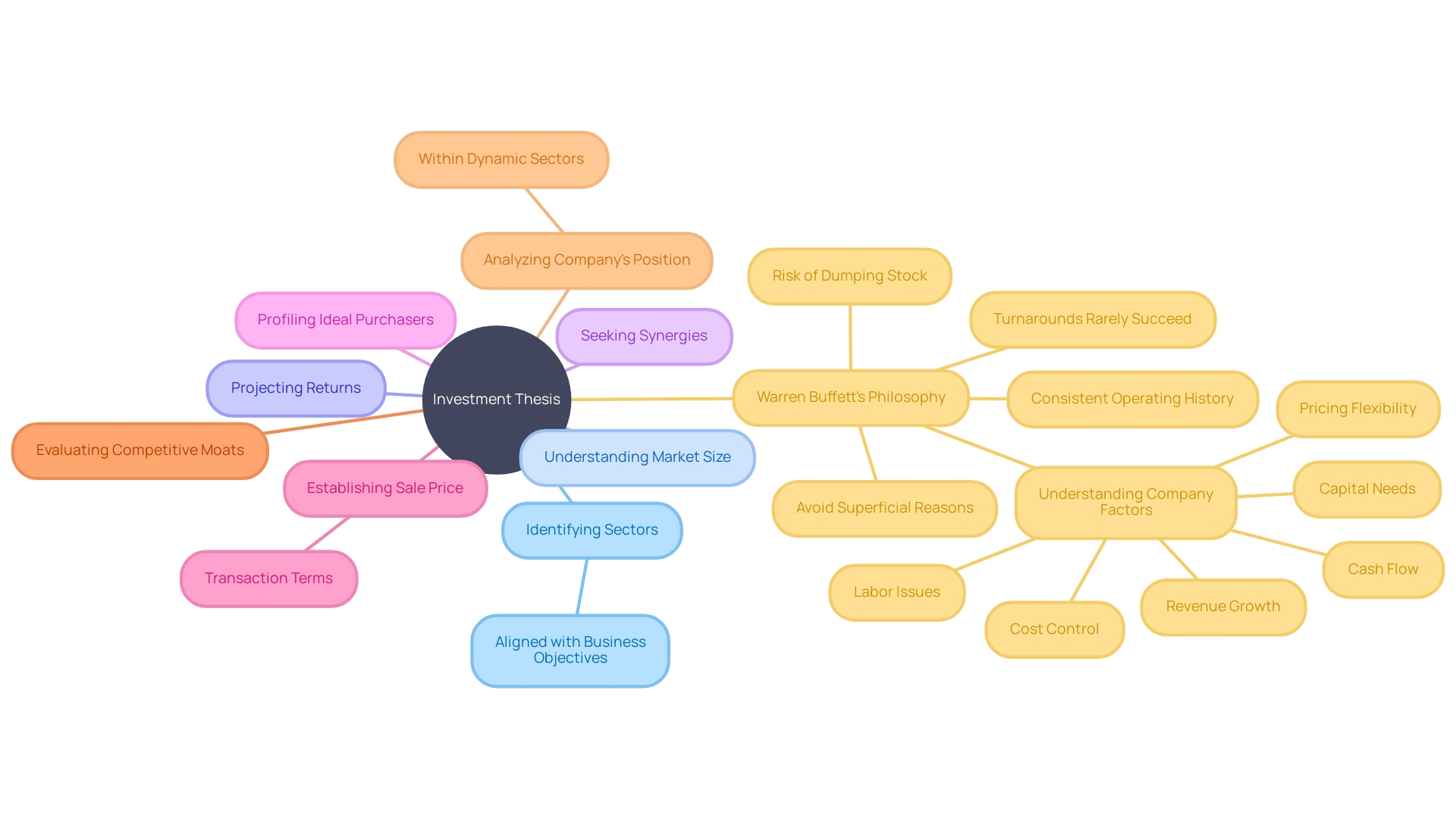Introduction
The process of buying or selling a business is a multifaceted decision driven by various motivations and strategic goals. Entrepreneurs seeking expansion consider acquisitions to strengthen their market presence, diversify income sources, or capitalize on fresh ventures. Conversely, business owners may sell to embrace retirement or navigate financial complexities.
However, the journey is not just transactional; it reflects future aspirations and present realities. Proper valuation is crucial to secure a fair deal, and neglecting it can be a critical misstep. Crafting an investment thesis and understanding market dynamics are pivotal in making informed decisions.
Thorough due diligence and a well-crafted letter of intent set the stage for successful negotiations. Assessing financials, assets, and contracts, as well as engaging with stakeholders, is essential. The role of the current owner post-acquisition and the development of a strategic business plan contribute to a seamless transition.
Securing funding and understanding legal frameworks are key to a successful transaction. Finally, closing the deal and managing the post-acquisition transition require meticulous planning and a strategic approach. Overall, buying or selling a business is a complex process that demands attention to detail, strategic vision, and effective communication with stakeholders.
Motivations for Buying or Selling a Business
Engaging in the acquisition or divestiture of a business is a multifaceted decision, driven by varied motivations that hinge on the strategic goals of the buyer or seller. Entrepreneurs eyeing an expansion often consider acquiring companies to bolster their market presence, assimilate cutting-edge technology, diversify their income sources, or capitalize on fresh ventures. Conversely, business owners might entertain selling as a strategic move to embrace retirement, new passions, or to navigate financial intricacies.
For those contemplating a sale, the journey is not merely transactional but a reflection of future aspirations and present realities. As Abhijeet Kaldate of Astra WordPress Theme suggests, envisioning where the business could be a decade down the line is crucial. This foresight is instrumental in gauging whether to accept a buyout offer, which, despite appearing attractive, may pale in comparison to the business's intrinsic value after a thorough valuation.
The decision to sell also often aligns with an entrepreneur's readiness for transition, with those most prepared for change finding the process smoother. As highlighted by experts, neglecting proper valuation stands as a critical misstep in selling a business. An accurate assessment of worth—considering financials, assets, customer base, and industry dynamics—is imperative to securing a fair deal.
This intricate dance of buying and selling businesses is punctuated by strategic exit strategies, which are as diverse as the businesses themselves. A well-crafted exit plan allows a business owner to gracefully reduce their stake, whether for profit, retirement, or other lucrative possibilities. Each strategy, from selling to a strategic buyer to initiating a buyout, is tailored to meet the specific needs of the business and the owner's objectives.
Defining Your Investment Thesis
Crafting an investment thesis is a pivotal step in the journey of acquiring or divesting a company, as it sets a clear strategic path. For buyers, this means pinpointing sectors that align with their business objectives, understanding the market size they aim to serve, projecting anticipated returns, and seeking out unique synergies or competitive edges. Sellers, on the other hand, should focus on profiling the ideal purchaser, establishing a target sale price, and specifying transaction terms they're prepared to accept.
Consider the success story of a leading independent insurance brokerage in the U.S., which attributes its growth to a decentralized model and a robust company culture. It's a testament to how well-defined strategic goals, like their focus on generating a majority of revenue through commissions in the domestic market, can lead to lucrative outcomes. The brokerage's growth model—impacted by premium rate changes and exposure units—highlights the importance of detailed investment criteria.
Warren Buffett's insights are particularly relevant here. He emphasizes the necessity of a business model that offers something distinctive and the prudent evaluation of a company's competitive moat. This principle applies whether you're buying a business with an aim to expand within an industry or selling one while seeking to maximize financial returns.
In the context of mergers and acquisitions, it's observed that sectors like banking, with its ongoing consolidation trend driven by regulatory pressures and the need for scale, can offer attractive opportunities. Analyzing a company's position within such dynamic sectors is a crucial component of a well-rounded investment thesis that aligns with Buffett's philosophy of identifying businesses with strong, defensible market positions.
Ultimately, your investment thesis should be a living document, reflecting the current market realities and your strategic vision, much like the analytical approaches of seasoned investors who focus on the intrinsic value and unique propositions of the businesses they invest in.

Finding the Right Business
Embarking on the journey of buying or selling a business is a strategic endeavor that demands a deep dive into the intricacies of the marketplace. As a potential buyer, it is crucial to immerse oneself in a thorough market analysis to pinpoint companies that not only align with your vision but also exhibit robust financial health and a competitive edge. Delving into a company's history, customer loyalty, brand strength, and product or service synergy with your objectives is paramount.
For those on the selling side, it's about connecting with buyers whose values resonate with yours, and who appreciate the true worth of your enterprise, facilitating a seamless transition.
Stephanie Wells from Formidable Forms advises, "An assessment of where your company will be in the next five or 10 years is the most important factor to consider when contemplating a sale." This forward-looking perspective is essential to gauge the long-term value of your business, beyond immediate lucrative offers.
The Akiya case study illustrates the importance of comprehending the full scope of a transaction. Like the client seeking a beachside property, having a clear criterion and expert guidance can lead to finding the perfect match, saving time, and avoiding unnecessary costs.
BizBuySell stands out as a comprehensive online marketplace, offering a plethora of businesses for sale across various industries and price points, complete with tools like their Business for Sale feature and valuable resources such as their guide to buying a small business.
However, a common pitfall when selling a business is neglecting proper valuation. As highlighted in the advice on selling businesses, "It's essential to have a clear understanding of your business's worth before entering into negotiations." Hiring a professional appraiser can provide you with the accurate valuation needed to negotiate effectively.
Staying informed and prepared is key to navigating this complex process. Whether you're an experienced entrepreneur or a novice in the business world, attention to detail and strategic planning will serve as your compass towards a successful transaction.

Pre-LOI Diligence and Pre-LOI Letter
Prior to drafting a letter of intent, it's crucial for both parties to engage in thorough due diligence. This involves meticulously reviewing financials, tax records, and legal agreements, including customer and employee contracts. The objective is to clearly understand the business operations, revenue generation methods, and the competitive landscape in which the company thrives.
It's imperative to have a comprehensive view of the target market's size and the company's strategy to capture its share. This process not only helps in assessing the transaction's viability but also in identifying any potential risks or areas that may require further negotiation. Keeping in mind the strategic nature of M&A, ensuring that there's ample runway before initiating the process is key, as this can significantly impact the dynamics of the deal.
Once the due diligence is complete, the interested buyer can then proceed to present a preliminary offer through a pre-LOI letter, setting the stage for more formal discussions.

The Letter of Intent
A Letter of Intent (LOI) serves as the foundation for any company transaction, laying out the essential terms and mutual commitments before finalizing a deal. The importance of an LOI becomes even more evident when considering the tactics used by acquisition teams to stretch negotiations, leveraging time to their advantage. As such, an effective LOI should clearly delineate the purchase price, elucidate payment structures, and propose a feasible timeline to keep the process on track.
It should also establish critical contingencies and articulate any unique conditions that may apply.
In the high-stakes environment of mergers and acquisitions, an LOI is not merely a formality but a strategic tool. For instance, when determining market entry strategies, alignment sessions play a crucial role. These discussions are not just about reaching agreement on the price but also on understanding the strategic fit of an acquisition within the broader business objectives.
The motivations behind a startup's decision to sell are multifaceted and deeply personal, as seen in the candid exchanges between founders and potential acquirers. It's a process where both parties seek to understand not just the financials but the underlying values and visions that drive a business.
Moreover, with the fluctuating economic landscape, as evidenced by the actions of the European Central Bank and the evolving business models of companies like Alteryx, it is imperative to craft Lois that are flexible yet precise. An LOI should reflect the current state of the market and anticipate future economic trends, ensuring that the agreement is robust enough to withstand external pressures while still capturing the essence of the deal.
Ultimately, an LOI is the culmination of a deep understanding of the market, the parties involved, and the value each brings to the table. It's a document that, while non-binding, holds great significance in the journey toward a definitive purchase agreement and the successful acquisition of one company by another.

Post-LOI Diligence
Upon entering the post-LOI phase, the scrutiny intensifies as both the acquiring and selling parties conduct in-depth post-LOI due diligence. This stage offers a window into the true health of a business, examining the sustainability and accuracy of its finances and operations, customer base reliability, intellectual property integrity, and adherence to legal and regulatory standards. Distilled from experience, seasoned entrepreneurs like Ben Schippers, co-CEO of HappyFunCorp, emphasize the importance of being thoroughly prepared for this phase.
The aim is to unearth any concealed liabilities or risks that could sway the deal's outcome.
The due diligence process is akin to validating the company's pulse—checking vital signs for robustness and growth potential. Abhijeet Kaldate of Astra WordPress Theme advises a forward-looking perspective, suggesting that a thorough appraisal of where the company is poised to be in the next decade is crucial. This helps in ascertaining whether the offer on the table truly reflects the company's value.
A Quality of Earnings (QoE) assessment becomes indispensable here, providing a microscopic view of the company's financial health. It probes the reliability of earnings and hunts for anomalies like revenue spikes or over-dependence on certain customers. Stephanie Wells of Formidable Forms points out that selling your business should not be approached lightly, and understanding the nuances of your business's worth is paramount.
Furthermore, cultural fit between merging entities is a critical metric that cannot be overlooked. A cultural integration plan must be devised to foster a unified corporate culture, leveraging the strengths of both the acquired and acquiring companies. This step is often the linchpin in realizing the full potential of the merger and avoiding pitfalls that could jeopardize the return on investment.
It's crucial to approach these negotiations from a position of strength. Having sufficient runway, as highlighted by industry veterans, ensures that the selling party is not cornered into unfavorable terms due to financial desperation. This phase is the culmination of strategic outreach and market trend analysis, and as data from the lower-middle market deals suggest, identifying right-fit buyers and leveraging reliable comps are essential for a meaningful transaction.
Armed with these insights, the post-LOI diligence is not just a reassurance of the company's standing but also a strategic step towards a successful and mutually beneficial acquisition.
Evaluating Business Financials
Understanding a company's financial health is paramount when considering a purchase or sale. For those looking to acquire a business, it's essential to delve into the financial details, such as scrutinizing financial statements, cash flow forecasts, and identifying any existing debts or liabilities. A thorough analysis of these documents can reveal the profitability and revenue trends of the company, as well as the robustness of its financial practices.
A tool like a Quality of Earnings (QoE) report is invaluable in this context, providing a deep dive into the sustainability and precision of the company's reported earnings, probing into revenue sustainability, and highlighting any customer concentration risks.
Sellers, in turn, must prioritize clarity and accuracy in their financial disclosures. Well-documented financial statements and tax records are more than just procedural—they are a testament to the company's integrity and can be a determining factor in securing the right buyer. Notably, an independent valuation is a strategic move for sellers.
It offers an objective assessment of the business's worth, mitigating the risk of undervaluation or overpricing, both of which can be detrimental to the transaction process. This approach is supported by industry experts who emphasize the significance of a credible valuation in maximizing the potential of a sale.
In the rapidly evolving economic landscape, a company's adaptability and operational efficiency are also under scrutiny. Prospective buyers are keen on evaluating how a business has responded to market shifts, technological advancements, and supply chain challenges. Similarly, marketing efforts and customer engagement strategies are indicative of a company's market position and potential for growth, making them a focal point of evaluation.
Whether it's the comprehensive insights from a QoE, the precision of an independent valuation, or the strategic analysis of operational and marketing efficiencies, these factors collectively inform both buyers and sellers, guiding them towards informed, strategic decisions in the complex arena of buying and selling businesses.
Assessing Assets, Inventory, and Equipment
Navigating the process of buying or selling a business involves a keen understanding of the value and condition of the company's tangible assets. For those on the cusp of purchasing a company, this means meticulously examining real estate, machinery, vehicles, and stock levels to ascertain their quality and potential to fit within your strategic vision. A comprehensive evaluation not only protects your investment but also ensures that the assets you acquire will propel your business objectives forward.
On the flip side, if you're positioning your company for sale, transparency and precision are your allies. Providing an itemized inventory and a realistic appraisal of your assets' worth are critical steps in fostering trust with potential buyers and securing a deal that reflects the true value of your enterprise. The stakes are high, as articulately put by Abhijeet Kaldate of Astra WordPress Theme: understanding the future trajectory of your company is paramount when considering an offer to sell.
This forward-looking perspective is invaluable in gauging whether the present offer is in line with the enduring value of your business.
Compounding the importance of accurate valuation is the intricate nature of tax implications, such as capital gains on receivables or the impact of the Alternative Minimum Tax (AMT) on the same year, as noted by financial planning experts. A fee-only financial planner, free from the conflict of selling products, can provide tailored advice to navigate these complexities, a move endorsed by the Canadian Federation of Independent Business to counter the scant 9% of small business owners who have a prepared exit strategy.
The commercial equipment industry is a testament to the fluctuating nature of asset value, as evidenced by agricultural equipment dealers preparing for market downturns and companies like Hyster-Yale navigating supply chain challenges to improve sales in 2024. This underscores the necessity of staying informed about current regulations and market trends that could influence the value of your assets at the time of sale.
A critical factor in this equation is the distinction between a share sale and an asset sale. The choice between these two predominant methods of selling a business carries significant financial and legal implications, making it imperative to understand the nuances of each before proceeding with a transaction.
In sum, a rigorous and informed approach to valuing your business's assets—supported by expert financial guidance and a grasp of market dynamics—places you in a position of strength, whether you're expanding your business portfolio or transitioning towards retirement. Leveraging professional valuation services positions you to negotiate from a place of confidence, ensuring that the final agreement mirrors the genuine worth of your business aspirations.
Understanding Contracts and Leases
Navigating the complexities of contracts and leases is crucial when you're on the brink of buying or selling a company. For buyers, delving into every existing agreement—from those with customers and suppliers to employee contracts—is pivotal. Scrutinizing these documents reveals the contractual terms, duration, and any latent risks or obligations that could sway the transaction.
It's also vital to uncover any clauses related to a change of control that might affect the deal's viability.
Sellers, on the other hand, have the responsibility to streamline the due diligence process by organizing and making all contracts and leases easily accessible for potential buyers. Additionally, they should be transparent about any imminent contract renewals or terminations, setting a clear stage for negotiations. According to insights from over 1,000 company contracts analyzed by the Common Paper platform, understanding the nuances of these agreements is not just a legal formality but a strategic move that could significantly influence the sale's outcome.
In fact, a well-maintained contractual ecosystem can be a strong selling point, as it assures continuity and stability post-acquisition—attributes highly valued by investors. For instance, Cloud Service Agreements, often an integral part of such transactions, show that 70% are penned on an annual basis with a high likelihood of automatic renewals, reflecting a preference for long-term stability in vendor-customer relationships. This data, coupled with the expertise of over 45 attorneys, underscores the importance of meticulous contract and lease management for both buyers and sellers in the dynamic arena of company acquisitions.
Business Licenses and Permits
Navigating the intricate world of business licenses and permits is a pivotal aspect of any transaction involving the acquisition or disposition of a company. When embarking on this journey, it's important to differentiate between the two: a license is a government-issued permission to engage in a particular activity, while permits are often related to specific projects or tasks. As highlighted by the U.S. Chamber of Commerce, they are not the same, and understanding this distinction is vital for both buyers and sellers.
For potential buyers, due diligence is key. It involves confirming that the business in question possesses all the requisite licenses and permits, ensuring it operates within the legal framework of its respective industry and location. This scrutiny helps unearth any underlying compliance issues or risks that might lurk beneath the surface.
On the flip side, sellers have the obligation to present all relevant documentation, verifying that their licenses and permits are not only current but also transferable, where applicable.
Recent legislative changes, such as Pennsylvania's Act 122, underscore the evolving nature of business compliance. With new amendments mandating annual reports and codifying the business judgment rule, staying abreast of these changes is crucial. Such legal shifts highlight the importance of maintaining up-to-date licenses and permits, as failing to comply can have significant consequences for business entities.
In essence, understanding the legal framework around business licenses and permits is more than a formality; it's a strategic step in safeguarding the value and legitimacy of a business during the buying or selling process. With the marketplace continually evolving, informed decisions based on a thorough grasp of licensing requirements are what set successful transactions apart.

Talking to Key Stakeholders: Customers, Employees, and Competitors
In the intricate dance of buying and selling companies, engaging with key stakeholders isn't just good practice—it's essential for capturing the true essence and potential of a business. Buyers, take note: it's your mission to dive deep into the heart of the company you're eyeing. Speak with customers to gauge their satisfaction, chat with employees to feel the pulse of morale, and study competitors to map out the market terrain.
This isn't just about due diligence; it's about uncovering the narrative that drives the business you're interested in.
On the flip side, sellers, your role is a delicate one. You're the steward of conversations that can make or break the deal. Keep the communication with stakeholders transparent to navigate concerns, ensure a seamless transition, and maintain the invaluable relationships you've cultivated.
Consider the case of an American in Japan, seeking a peaceful retreat by the Chiba Prefecture's sandy shores. The individual's quest led to a partnership with professionals who listened intently, understood the vision, and painstakingly scoured the countryside to pinpoint properties that aligned perfectly with the client's aspirations. Their journey underscores the significance of stakeholder engagement in transforming ambitions into reality.
As we look at the global stage, take inspiration from the company active in over 23 countries, with a portfolio that spans diverse industries. Their culture, rooted in entrepreneurship and innovation, illustrates the importance of strategic alignment and a comprehensive understanding of market dynamics in facilitating successful acquisitions.
Echoing the insights of industry experts, it's crucial to align your goals with those of your stakeholders to pave the way for successful negotiations. Whether you're navigating the complexities of an Akiya purchase or contemplating a strategic acquisition, remember: the quality of your stakeholder relationships can be the linchpin that secures a competitive edge and propels your business forward.
The Role of the Current Owner in the Business
The synergy between a buyer and seller, and the role of the outgoing owner post-acquisition, are pivotal to the smooth transition of a business. Buyers must weigh the benefits of retaining the seller's expertise as perhaps a consultant, ensuring a seamless handover of relationships and operational know-how. Sellers, in turn, need to gauge their willingness to support the business post-sale to preserve its legacy and value.
A study underlining the critical nature of these discussions points out that CEOs who view change as an opportunity can drive successful business transformations. A well-orchestrated transition, supported by clear communication about the owner's future role, can result in increased sales and customer satisfaction, as seen in the case of a major hotel that revamped its dining strategy. Furthermore, as the process of buying a company evolves, transparency in the transition phase becomes even more crucial.
It's not just about the sale; it's about ensuring the ongoing success of the business under new ownership.
Developing a Business Plan
Crafting a strategic business plan is a pivotal step for both prospective buyers and current owners contemplating the sale of their company. For buyers, this plan should encapsulate their vision for the enterprise post-acquisition, along with a roadmap of strategies and detailed financial forecasts. This not only aids in evaluating the viability of the purchase but is also instrumental in securing necessary funds.
On the flip side, sellers must prepare a business plan that underscores the current strengths and future potential of their enterprise. Such a document can serve as a powerful tool in negotiations, helping to attract serious acquisition offers and substantiate the valuation they seek.
A business plan goes beyond mere financial projections; it's a reflection of a company's ambition and operational blueprint. It provides a comprehensive view of the organization's objectives, the tactics it will employ to achieve them, and the metrics by which success will be measured.
In the context of mergers and acquisitions, such as roll-up strategies, a robust business plan can be particularly vital. It demonstrates how the integration of target companies can enhance the operational efficiency and market reach of the platform company, which is essential for success in these complex transactions.
Furthermore, the insights offered by experts like Abhijeet Kaldate emphasize the importance of forecasting the long-term trajectory of your company. This foresight is crucial when evaluating whether to accept a buyout offer, ensuring you make a decision that aligns with the true worth and future prospects of your business.
Additionally, having such a strategic document in place is echoed in the advice of industry leaders, pointing to the significance of preparedness in navigating the intricate process of selling a business. By meticulously outlining the core elements of a business plan, you position yourself to capitalize on opportunities and steer through the challenges that come with buying or selling a company.

Securing Funding and SBA Loans
When navigating the intricate path of acquiring or selling a business, securing the right funding is a pivotal element of the transaction. Prospective buyers must carefully examine a variety of financing avenues. This could range from conventional bank loans, which often come with competitive rates but may present a challenge to obtain, particularly for small or new enterprises, to more specialized options like Small Business Administration (SBA) loans, designed to bolster smaller ventures with more accessible terms.
A comprehensive approach to financial due diligence is imperative, demanding a deep dive into the business's worth. This valuation is not merely an exercise in number-crunching but a strategic move to ensure that both buyers and sellers are armed with a strong negotiating position. As one expert puts it, neglecting proper valuation can result in undervaluing a business or asking too much, either of which can derail potential deals.
Moreover, grants emerge as an underutilized yet potentially transformative resource. Ranging up to $100,000, these funds can fuel growth and expansion in various sectors, from beauty to technology. However, it's crucial to align with each grant's specific criteria and intended purposes.
For women entrepreneurs, particular attention should be paid to federal contracting opportunities, with at least 5% of contracting dollars earmarked for women-owned small businesses.
Ultimately, whether it's through meticulous preparation of financial records to satisfy lender scrutiny or tapping into specialized funding sources, the quest for financing in buying and selling businesses must be approached with a comprehensive strategy and an eye for detail.
The Asset Purchase Agreement
An Asset Purchase Agreement (APA) is a fundamental legal framework that meticulously records the specific terms of a business transaction. It's more than just a formality; it's a tailor-made document that captures the essence of the deal, safeguarding both buyer and seller by detailing the agreed-upon purchase price, the conditions of payment, and the precise assets to be transferred. The APA also outlines representations, warranties, and post-closing responsibilities, which are crucial for averting future disputes.
To illustrate, let's consider an acquisition scenario in Chiba Prefecture, Japan. An American, seeking a life closer to the serene beaches and away from the hustle of Tokyo, initiated an Akiya property purchase. The process began with a clear understanding of the client's preferences and a commitment to transparency throughout the transaction.
In a similar vein, crafting an APA requires a thorough understanding of the business's present and future potential, something that experts like Abhijeet Kaldate from Astra WordPress Theme emphasize when considering the sale of your company.
In the dynamic world of mergers and acquisitions, the APA stands as a testament to the strategic planning that goes into each transaction. Lawyers, accountants, and brokers bring their expertise to the table, ensuring that every angle is considered and that the inherent value of the business is both recognized and respected. With forward-looking statements providing a glimpse into the future, stakeholders can make informed decisions based on projections and estimates.
The agreement process is a strategic undertaking, as highlighted by the alignment sessions mentioned by experts in the field. These sessions serve as a platform for stakeholders to align their interests and set clear objectives for the acquisition. Whether the goal is to expand market reach, enhance product offerings, or simply capitalize on an investment, an APA encapsulates the strategic direction and commitment of all parties involved.
In conclusion, the crafting of an APA is a meticulous and strategic process that benefits greatly from the insights and experiences of those who've navigated the complex terrain of business transactions. By leveraging case studies, expert quotes, and industry news, one can gain a comprehensive understanding of the significance and intricacies of this crucial document.
Closing the Deal and Exchanging Money
Sealing the deal on selling your company is more than just a handshake; it's the culmination of meticulous planning and a strategic approach. It's critical for both buyers and sellers to collaborate, ensuring all necessary documentation is executed, funds are appropriately transferred, and any outstanding conditions are addressed. It's a period marked by coordination with legal and financial experts to ensure every aspect of the closing is smooth and precise.
Envisioning the future of your business is a decisive factor in this phase. Pondering where your company could stand in the next decade helps in weighing the decision to sell against a lucrative offer. As Stephanie Wells of Formidable Forms puts it, understanding your business's true worth is essential before making such a significant decision.
Chris Voss, the author and negotiation expert, applies his wealth of knowledge from high-stakes situations to the business sale process, underscoring the importance of negotiation skills. The closing process is also a reflection of your business's potential, similar to how undervalued companies in the stock market may forecast robust growth. As reported, these companies are poised for a strong performance, analogous to ensuring your business is viewed favorably by prospective buyers.
In this critical juncture, remember that the success of a business sale often hinges on the entrepreneur's readiness, as per the insights of entrepreneurs since 1996. Those who willingly choose to sell typically navigate the transition more successfully.
The process also involves a thorough preparation phase, where a deep dive into your company's financials, strategies, and market differentiators is conducted. GrowthPoint emphasizes this 'Data Prep' phase, equipping you and potential investors with the necessary insights for an informed transaction. By aligning your business objectives internally, you pave the way for a strategic and beneficial sale or acquisition, ensuring the final deal aligns with the long-term vision for your business.
Post-Acquisition Transition
Closing the deal on a business acquisition is an intricate process, but it's what comes next that truly shapes the future of the investment. As new owners take the reins, they must adeptly navigate the intricacies of integrating the newly acquired company into their portfolio. This crucial post-acquisition phase focuses on aligning systems and processes, safeguarding and managing data, and maintaining the delicate balance of existing operational and analytical teams.
For buyers, it's imperative to ensure a seamless transition by preserving the core value drivers of the business: its people and its customers. Key personnel must be retained, and customer relationships nurtured, to uphold the company's operational integrity and revenue streams. The consolidation of data architectures and IT governance is no less critical, as it underpins the company's ability to function efficiently and scale effectively.
Sellers, meanwhile, have their own set of responsibilities. They must facilitate a smooth transfer of knowledge and oversight, offering support where needed to the new custodians of their former enterprise. Any residual matters must be addressed with diligence, ensuring that the transition is as smooth as possible for all parties involved.
Case studies across industries have revealed that the success of this transitional phase hinges on the meticulous management of data—its storage, protection, and analysis—as well as the integration of disparate technologies. In a world where data is king, a company's cybersecurity profile, system infrastructure, application portfolio, and technical debt all play pivotal roles in the realization of an investment thesis.
Recent market dynamics, like those experienced by Alteryx Inc, illustrate the turbulent waters companies must navigate in the post-acquisition period. Facing fierce competition and operational challenges, it's a stark reminder that the real work begins only after the ink has dried on the deal.
In the end, the path to a successful merger or acquisition is paved with strategic foresight and the ability to execute a well-thought-out integration plan. It's a journey that demands patience, resilience, and the strategic acumen to merge not just companies, but cultures, systems, and visions for a shared future.

Conclusion
Buying or selling a business is a complex process that requires careful consideration, strategic planning, and effective communication with stakeholders. It is driven by various motivations and goals, such as expanding market presence, diversifying income sources, or navigating financial complexities. Proper valuation, crafting an investment thesis, and understanding market dynamics are essential for making informed decisions and securing a fair deal.
Thorough due diligence and a well-crafted letter of intent set the stage for successful negotiations.
Assessing financials, assets, and contracts, as well as engaging with stakeholders, is vital during the buying or selling process. The role of the current owner post-acquisition and the development of a strategic business plan contribute to a seamless transition. Securing funding and understanding legal frameworks are key to a successful transaction.
Closing the deal and managing the post-acquisition transition require meticulous planning and a strategic approach.
Throughout this journey, effective communication with stakeholders and alignment of goals are crucial. Engaging with customers, employees, and competitors provides valuable insights into the true essence and potential of a business. The role of the outgoing owner post-acquisition is important in ensuring a smooth transition and preserving the business's legacy.
Crafting a strategic business plan and securing the right funding are pivotal steps for both buyers and sellers. A well-defined plan helps evaluate the viability of a purchase and attracts serious acquisition offers.
Sealing the deal and exchanging money requires meticulous planning and a strategic approach. It is important to understand the true worth of the business and negotiate from a position of strength.
The post-acquisition transition is a critical phase that focuses on integrating the newly acquired company into the portfolio. Preserving core value drivers, aligning systems and processes, and managing data are key factors in ensuring a successful transition.
In conclusion, buying or selling a business demands attention to detail, strategic vision, and effective communication with stakeholders. By following a well-structured process, conducting thorough due diligence, and embracing strategic planning, both buyers and sellers can navigate the complexities of the transaction and achieve their desired outcomes.




